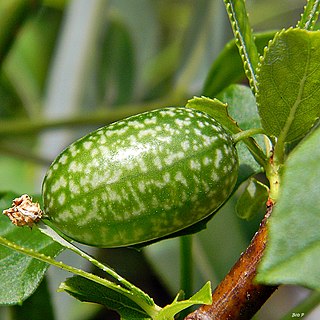
The Cucurbitaceae, also called cucurbits or the gourd family, are a plant family consisting of about 965 species in 101 genera. Those most important to humans are the following:

Prosopis is a genus of flowering plants in the family Fabaceae. It contains around 45 species of spiny trees and shrubs found in subtropical and tropical regions of the Americas, Africa, Western Asia, and South Asia. They often thrive in arid soil and are resistant to drought, on occasion developing extremely deep root systems. Their wood is usually hard, dense and durable. Their fruits are pods and may contain large amounts of sugar. The generic name means "burdock" in late Latin and originated in the Greek language.

Melastomataceae is a family of dicotyledonous flowering plants found mostly in the tropics comprising c. 175 genera and c. 5115 known species. Melastomes are annual or perennial herbs, shrubs, or small trees.

Cucumis is a genus of twining, tendril-bearing plants in the family Cucurbitaceae which includes the cucumber, true melons, the horned melon, and the West Indian gherkin.

The plant tribe Phaseoleae is one of the subdivisions of the legume subfamily Faboideae, in the unranked NPAAA clade. This group includes many of the beans cultivated for human and animal food, most importantly from the genera Glycine, Phaseolus, and Vigna.

Sicyos is a flowering plant genus of the family Cucurbitaceae. Members of the genus may be known as "burr cucumbers", but the genus includes Sicyos edulis which is the christophine or chayote.

Canavalia is a genus of plants in the legume family (Fabaceae) that comprises approximately 62 species of tropical vines. Members of the genus are commonly known as jack-beans. It has a pantropical distribution.

Gochnatia is a genus of flowering plants in the daisy family, Asteraceae. It is named for botanist Frédéric Karl Gochnat. The genus contains mainly shrubs and subshrubs, with a few trees and herbs. All of the species are native to the American tropics. Two species native to the mountains of Southeast Asia and formerly included here are now separated as the genus Leucomeris in subfamily Wunderlichioideae.
Apodanthera mandonii, known as ckoto-ckoto, is grown for its edible tuber. It is native to the Andes, ranging from Ecuador to Peru and Bolivia.

Zehneria is a genus of flowering plants – of vines in the cucumber and gourd family, Cucurbitaceae. It contains about 35 species ranging from Africa, through Southeast Asia to Australia and Oceania. The name honours botanical artist Joseph Zehner.

Cayaponia is among the largest genera in the gourd family, Cucurbitaceae, with 74 species. The plants are referred to as melonleaf. They are common from the southern United States to South America. Some species are also found in western Africa, Madagascar, and Fernando de Noronha, which is about 354 km (220 mi) off the coast of Brazil.

Kedrostis is a genus of ± 35 species climbing or trailing herbs in the family Cucurbitaceae. Its native range is tropical Africa and Asia.

Sonerila is a genus of plants in the family Melastomataceae. This genus is characterized the by presence of three petals as opposed to five in the other members of the family. Most members of the genus prefer growing in shady habitats. It is a large genus including about 175 species.

Melothria is a genus of flowering plants in the family Cucurbitaceae, native to the Americas from the United States to Argentina, and with some introductions in Africa and elsewhere. A number of Old World species formerly in Melothria were reassigned to Cucumis.

Gurania is a genus of flowering plants belonging to the family Cucurbitaceae.
Helmontia is a genus of flowering plants belonging to the family Cucurbitaceae.
Pteropepon is a genus of flowering plants belonging to the family Cucurbitaceae.
Melothria pringlei is a species of flowering plant in the cucurbit family, with a native range spanning Mexico to Honduras. It was first described by Sereno Watson in 1890 and placed in the genus Apodanthera, but was reclassified as belonging to the genus Melothria in 1954 by Raul Martinez Crovetto. Melothria pringlei has a prostrate habit, with scabrous stems that root where they touch the ground. Its leaves are scabrous and lobed, and grow 1–3 in (2.5–7.6 cm) in length, with a slightly smaller width. It is a monoecious species, with each plant producing both male (staminate) and female (pistillate) flowers, which are small.
Hanburia is a genus of plants in the tribe Sicyoeae of the gourd family, Cucurbitaceae. Its native range is from Mexico to Venezuela and Peru. It is found in the countries of Colombia, Costa Rica, Ecuador, Guatemala, Honduras, Mexico, Panamá, Peru and Venezuela.














